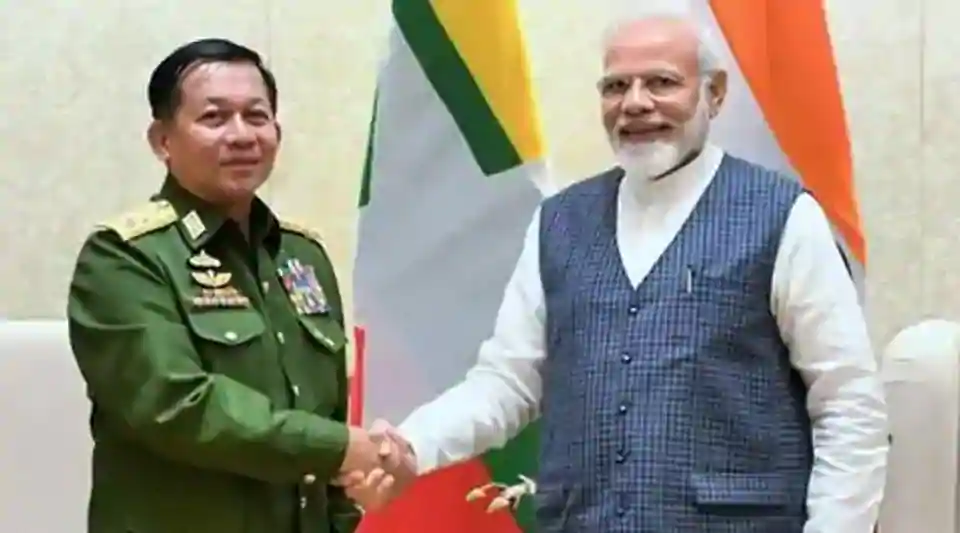
SOURCE: HT
Indian Army chief Gen Manoj Mukund Naravane and foreign secretary Harsh Shringla are expected to travel to Myanmar in early September to strengthen bilateral ties by reviewing projects and seek help from Commander-in-Chief Senior General Min Aung Hliang to target anti-India insurgents on its western borders, people familiar with the matter said.
India is most concerned about the resurgence of its two terror groups, Arakan Army and Arakan Rohingya Salvation Army. The Arakan Army has been targeting the Kaladan Multi Modal Transit Transport Project, a $484 million effort funded by India to link Myanmar’s Sittwe port to Mizoram by using the Kaladan river for transportation of goods for trade. Once complete, the project, first proposed 20 years back, would open India’s landlocked north-east to the Bay of Bengal through Mizoram and provide alternative connectivity to Kolkata without goods taking the circuitous route through the Siliguri corridor.
Officials said there had been an increase in instances of action to disrupt the project by the Arakan Army, which had been trained by the China-backed Kachin Independence Army up north. There have also been numerous complaints of extortion from people working on this project, particularly after an expansion in the ranks of the Arakan Army in end-2018, the people cited above said.
Myanmar is also open to deepening security cooperation between the two sides. The Myanmar Army has, in recent years, been working with Indian troops to curb anti-India insurgent groups that are based, and operate from across the Moreh border in Manipur and across Changlang district in Arunachal Pradesh.
These groups, armed with illegal Chinese weapons coming through Ruili in the bordering Yunnan province of China, however, have been under pressure due to operations conducted by soldiers of both countries. In May this year, Myanmar had handed over a group of 22 northeast insurgents wanted in Manipur and Assam.
In preliminary discussions ahead of the Myanmar visit by the army chief and foreign secretary Shringla, the Myanmar Army has indicated its willingness to deploy more troops on border with India to control groups such as the NSCN (K), ULFA, PLA and NSCN (IM), a senior Indian army commander said.
It is on account of action taken by Myanmar and Bangladesh in recent years that United Liberation Front of Asom chief Paresh Baruah, shifted to China’s Yunnan province where he has been hosted by Chinese intelligence officials who have been working hard to support groups that foment trouble in India’s northeastern region.
Gen Naravane and Harsh Shringla are scheduled to meet the top leadership of Myanmar including Senior General, Vice Senior General Soe Win, State Counsellor Aung San Suu Kyi and other senior leaders. At these meetings, China will be the elephant in the room.
The Myanmar government has not only allowed China access to the Andamans Sea through the $ 1.3 billion Kyaukphyu deep sea port in Rakhine, it has also become a contributor to Beijing’s energy security requirements through exploitation of gas blocks under the China-Myanmar Economic Corridor.
For years, Beijing – Naypyidaw’s top foreign investor and supplier of military hardware – has been trying to retain Myanmar as its geostrategic stomping grounds, funding infrastructure and energy projects and even, supporting armed groups that are fighting bloody battles.
Like when Naypyidaw held peace talks in 2017, Beijing flew a plane load of rebel leaders from the Chinese city of Kunming to participate in the conference. Last year when the military busted a huge cache of weapons including surface-to-air missiles, Myanmar made a pointed reference to the Chinese origin of the weapons. This year, Senior General Hliang told a Russian television channel that terrorist organisations active in Myanmar were backed by ‘strong forces’, a reference to China.
When Xi Jinping flew down in January this year, Naypyidaw signed 33 pacts when the Chinese President was in town. It was the first visit by the Chinese President in 19 years. The Kyaukphyu deep sea port was only one of them, designed to provide Beijing a stepping stone to the Indian Ocean.
Many analysts have, however, pointed that there were occasional efforts over the last decade in Myanmar to emerge out of China’s orbit, despite its limited successes. There have also been concerns about the huge loans being taken by Myanmar to fund Xi Jinping’s Belt and Road Initiative projects like the deep sea port in Myanmar, amid fears that it could, like Sri Lanka and Pakistan, end up slipping into China’s debt trap.
Myanmar has so far held its ground on the 2011 decision to suspend the $3.6 billion dam in the Myitsone dam in ethnic Kachin state that faced local protests. The dam, counted among the biggest hydro power projects in the region, had angered Beijing’s State Power Investment Corporation, the main investor.






